Sea Level Rise 101
The causes and effects of this undeniable consequence of climate change—and how communities can respond.
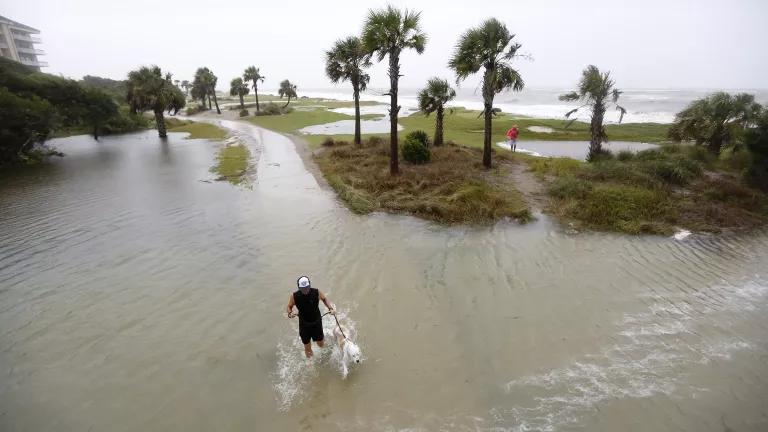
High tide flooding is becoming more common in South Carolina’s Lowcountry, such as the Isle of Palms (pictured).
Mic Smith/AP Photo
We hear a lot about sea level rise. It’s long been fodder for sci-fi movies, like Waterworld and The Day After Tomorrow, which haunt audiences with images of people clinging to ramshackle floats and New York City’s Statue of Liberty submerged beneath the waves, her iconic torch teetering above the waterline.
But what do we really know about sea level rise? A lot, actually. To date, sea level rise has been occurring on a relatively slow time frame, measured in fractions of an inch per year. If you live in a coastal area, you may not notice that the tides seem higher, or that standing water lingers more frequently and for longer periods of time. Or you may just chalk that up to other reasons, like an unusually high tide on a full moon.
Unfortunately, global sea levels are going to start rising much faster within the next few decades. While Lady Liberty might not need swim lessons, parts of the United States will see as much as 1–2 feet by 2050—with climate tipping points threatening to multiply the challenges. Read on for more about sea level rise, and what we can do to prepare for the climate realities before us.
What is sea level rise?
Sea level rise, as the name implies, is an increase in the total volume of ocean water. It results from the addition of melting glaciers and polar ice sheets, as well as the natural expansion of water as it warms—both consequences of climate change, which is driven by the burning of fossil fuels.
Types of sea level rise
Believe it or not, the sea isn’t actually level. Because the earth itself is lumpy, the effect of gravity is uneven around the globe, subtly pulling more water into certain places than others. At the same time, the tides, ocean currents, and storms also cause ocean water to “pile up” in certain areas, leading to local variations in sea levels. Scientists who study sea level rise—using tide stations and satellite laser altimeters—try to account for all these complexities to hone in on long-term changes.
There are two types of sea level rise:
- Global mean sea level rise (also known as absolute sea level change) is the global average sea level compared to a fixed point, such as the center of the earth. This is the kind of sea level rise most related to climate change. Think of it as an increase in the total amount of space that the ocean takes up. (It may also be referred to as eustatic sea level rise.)
- Relative sea level change (also known as local or isostatic) describes the height of the ocean’s surface compared to a specific piece of land. Increases may be caused by the water rising due to ocean dynamics, but it also may be that the land is sinking.
Sea level rise data
In their staggering 2022 report, U.S. agencies, including the National Oceanic and Atmospheric Administration (NOAA), give a range of five possible sea level rise scenarios based on future rates of greenhouse gas emissions, featured in the sea level rise graph below. These scientists project that global mean sea levels will rise almost 1 foot (0.28 meter) above 2000 levels by 2050—and above 3 feet (1 meter) by 2100. This is our “intermediate” scenario. And if we fail to take significant action on climate change, as projected in the “high” scenario, sea levels could rise as much as 6.6 feet (2 meters) on average by the end of the century.
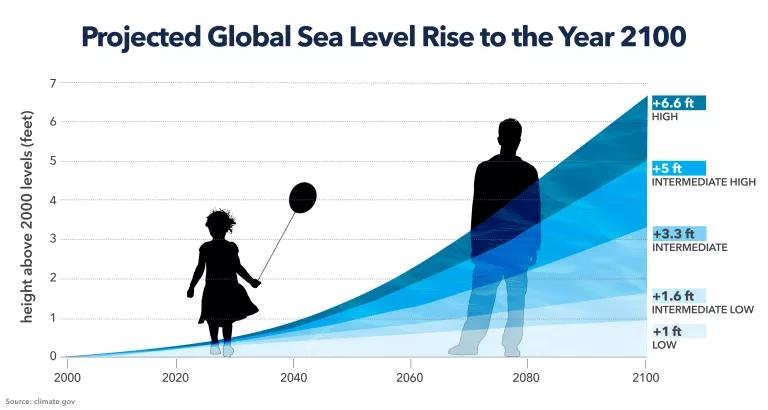
Future sea levels through 2100, based on the five future pathways described in the NOAA’s 2022 report, Global and Regional Sea Level Rise Scenarios for the United States. These pathways differ depending on future rates of greenhouse gas emissions and glacier and ice sheet loss. The “low” scenario is based on the world sharply lowering emissions, while the “intermediate” and higher scenarios are associated with higher global emissions. Human figures are added to show the relative height of sea level rise.
Graphic by NRDC. Information from climate.gov, adapted from Sweet et al., 2022.
Even today, with an average global sea level rise of just 1/8 of an inch every year (about 3.6 millimeters)—more than double the yearly rate of the 20th century—we’re seeing saltwater intrusion impact infrastructure, agriculture, and coastal ecosystems. And again, these rates are global averages.
In the United States, seas are rising slower in some places like the Pacific Northwest, where tectonic plates are shifting land upward. But they are rising much faster on the East Coast, which should anticipate about a foot of rise (14–21 inches or 0.36–0.54 meters) by 2050. The western Gulf of Mexico, which is experiencing the fastest sea level rise in the United States, should expect 19.3–27.2 inches (0.49–0.69 meters) in the next 30 years. That’s equal to the total rise in the region seen over the past 100 years.
Projected ranges for sea level rise are reasonably tight because in the near term, we can reliably estimate how much carbon pollution will be released and how the earth’s climate will respond. The range of uncertainty grows over the longer term because absolute sea level rise is accelerating, and pinning down the rate of acceleration, as well as the rate of ice sheet loss, is a complex challenge. One unknown factor is the pace at which the world’s most polluting countries and companies will reduce their global warming emissions.
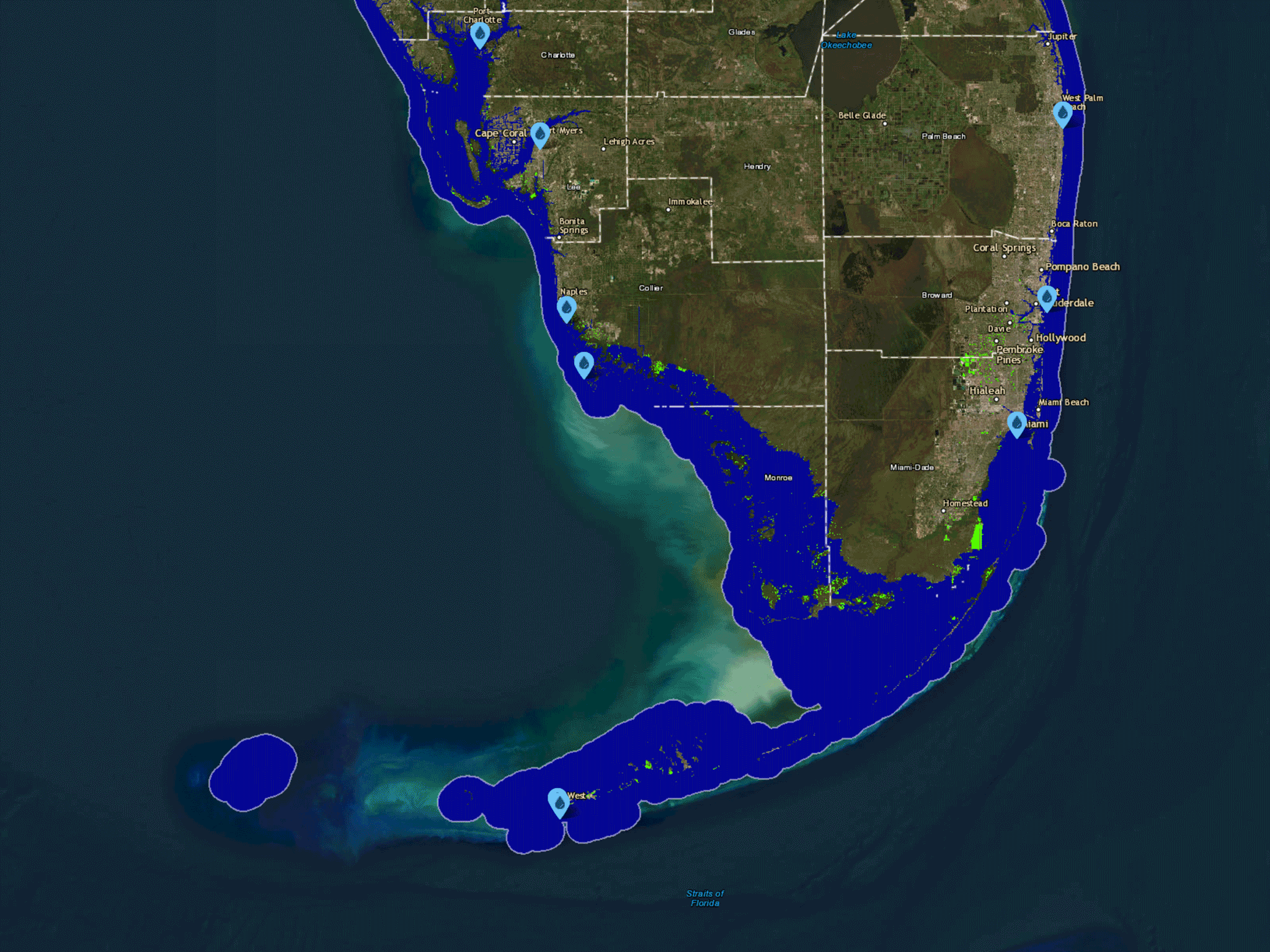
The NOAA Sea Level Rise Viewer map uses modeling simulations to show the scale of potential coastal inundation, starting from today’s average height of the highest daily tide (known as the mean higher high water or MHHW) up to 6 feet (1.8 meters) of sea level rise. The images are based on information from the NOAA Office for Coastal Management’s Digital Coast, including detailed elevation maps and local tide variability, and are meant to help local decision makers estimate impacts of different sea level rise scenarios.
Global causes of sea level rise
Global sea level rise has two primary causes: melting ice and the expansion of seawater as it warms. Climate change is causing both.
Melting ice
As climate change leads to an increase in the average temperatures at the earth’s polar regions, the ice sheets are melting into the ocean and causing sea levels to rise. Meltwater from ice sheets in Greenland and Antarctica is a major driver of the global average rise in sea levels since at least 1993, with satellite data suggesting that the Greenland ice sheet alone sheds about 270 billions tons of ice mass every year.
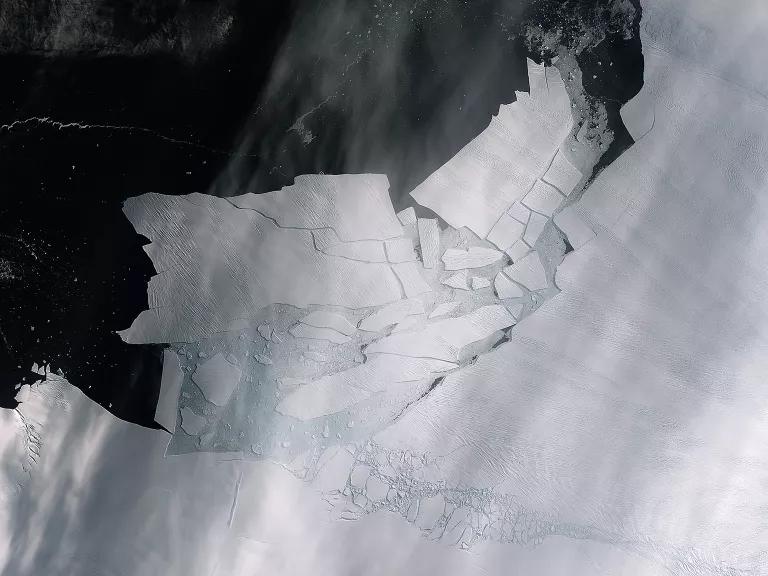
An iceberg more than 115 square miles in size shatters into pieces after breaking off from the Pine Island Glacier in Antarctica in 2020.
European Space Agency
Thermal expansion
Physics 101 says that liquids expand when heated. You can see thermal expansion at work in a mercury thermometer: As the temperature rises, the mercury expands, causing it to fill more of the glass tube.
The oceans absorb 90 percent of the excess heat trapped by greenhouse gases. As climate change heats the oceans, the water gets bigger, even if the total amount of water were to remain constant. Since the ocean basin isn’t getting bigger, the water level is pushed upward, just like the mercury in the thermometer. NOAA scientists have estimated that one-third of global sea level rise since 2004 is due to warming of the water.
Local causes of sea level rise
Some causes of local or relative sea level rise—when the waters rise relative to one particular place—are related to climate change, while others are related to the land itself sinking or lifting.
Local geology
The city of Norfolk, Virginia, for example, is built on a massive impact crater, where a space rock struck the planet 35 million years ago. This unusual geological situation, in addition to other causes, has resulted in the slow sinking of land in parts of the city. This makes the sea appear to be rising faster.
Tectonic shifts
Tectonic shifts and vertical land motion can mask the effects of rising sea levels. Parts of coastal California, for instance, are being slowly pushed upward. And the powerful earthquake that hit Japan in 2011 dropped parts of Honshu’s coasts by 2 feet (0.6 meters).
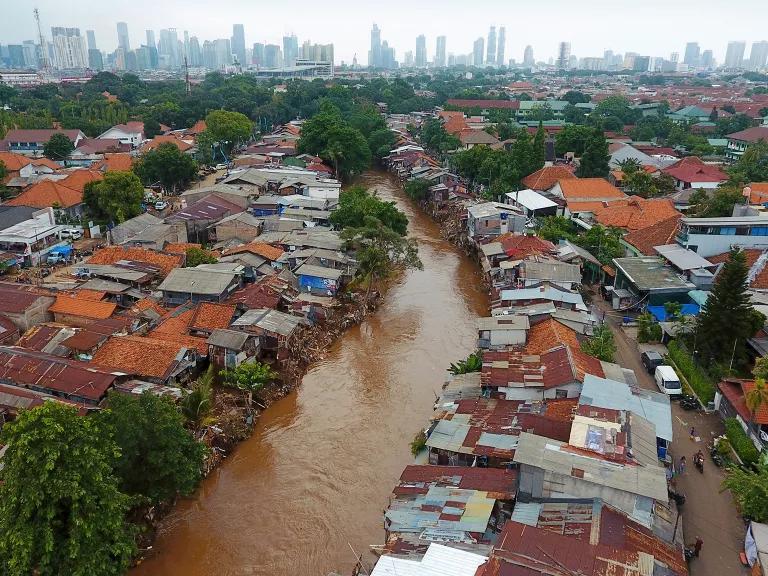
Homes on the banks of the Ciliwung River in Jakarta, Indonesia, a city that is starting to sink.
Dimas Ardian/Bloomberg via Getty Images
Groundwater pumping
Pumping out the groundwater beneath a city can cause it to settle into the earth, creating a relative rise in sea level. Such is the case in Jakarta, Indonesia, where sinking has been so devastating that the government plans to replace it with another city as the nation’s capital.
Climate change
Global climate change can contribute to local sea level rise due to changing ocean dynamics, as well as thermal expansion and land ice loss. For instance, the Atlantic Meridional Overturning Circulation (AMOC) is a massive churn of water, driven by differences in the ocean’s saltiness. There is growing concern that melting polar ice is diluting the salinity of water in the northern Atlantic Ocean and slowing the current. If the Gulf Stream, a portion of the AMOC, slows down, water would pile up along the east coast of the United States, where sea levels are already rising more quickly than in other areas.
Effects of sea level rise
Rising seas threaten a series of disasters. And it’s important to point out that sea level rise can have vastly uneven effects, not only because water levels are rising faster in some places, but because some communities are more vulnerable to political and economic instability. Without help, inequality will be worsened in areas that have the least resources to adapt.
Here are some of the major effects of sea level rise.
More extreme weather and flooding
Sea level rise escalates the threat of extreme weather. When a hurricane or major storm strikes, the water level rises and strong winds send the water surging inland—what’s known as storm surge. When the water levels are already high to begin with, storm surge and flooding will be more frequent and dangerous.
Tidal flooding
In addition to the flooding associated with extreme weather, many coastal areas are experiencing increasing numbers of high tide floods (also known as “nuisance” or “sunny day” floods), when the sea washes up and over roads and into storm drains as the daily tides roll in. NOAA projects that by 2050, the United States will experience an average of 45 to 85 high tide flooding days per year.
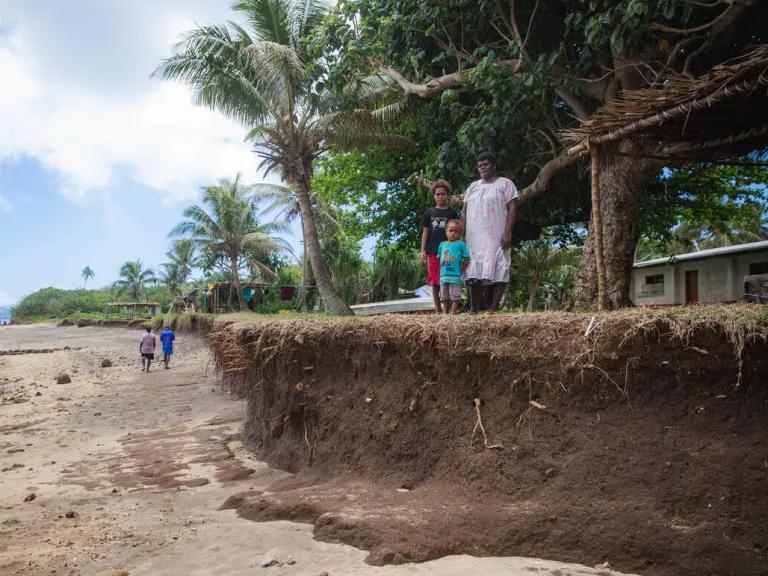
Sea level rise and coastal erosion on Emao Island, Vanuatu, are threatening the homes, livelihoods, and lives of residents.
Niki Kuautonga/Greenpeace
Land loss and coastal erosion
While many areas will be impacted by higher storm surges and daytime flooding, some areas of land will be permanently submerged or degraded by water. Research from Climate Central estimates that by 2050, 4.4 million acres of individual properties in the United States are projected to be at least partly below tide lines. For island communities that rise only a few meters above the water, sea level rise is an existential threat. The loss is more than terrestrial and economic but cultural as well.
Economic impacts
In the United States, coastal erosion is already responsible for $500 million in annual property loss. As sea level rise accelerates, so will those figures, because the water will begin to damage very expensive and immovable infrastructure like sewage treatment plants and power stations. For instance, there are nearly 300 energy facilities that are within 4 feet of the current level of high tide. Transportation is also vulnerable: The Gulf Coast region alone has 2,400 miles of roadway at risk of permanent flooding.
If world leaders fail to mitigate climate change, we risk trillions of dollars in economic losses by 2100. According to a 2018 study, dealing with this problem—by moving what can be moved, building seawalls, or rebuilding the structures further inland—will cost humanity $14 trillion every year by the end of the century.
Saltwater intrusion and freshwater contamination
Rising seas are introducing saltwater into inland freshwater sources such as aquifers. This risks contaminating the drinking water in coastal areas, including major cities like Miami, New Orleans, and Shanghai, fueling water insecurity and displacement, especially in places that cannot afford costly fixes like water treatment plants.
It’s also contaminating farmland, as more salt is introduced into freshwater sources, as well as the soil itself. We’re seeing this play out in Bangladesh, where the loss of large swaths of farmland is forcing people off the lands their families have worked for generations.
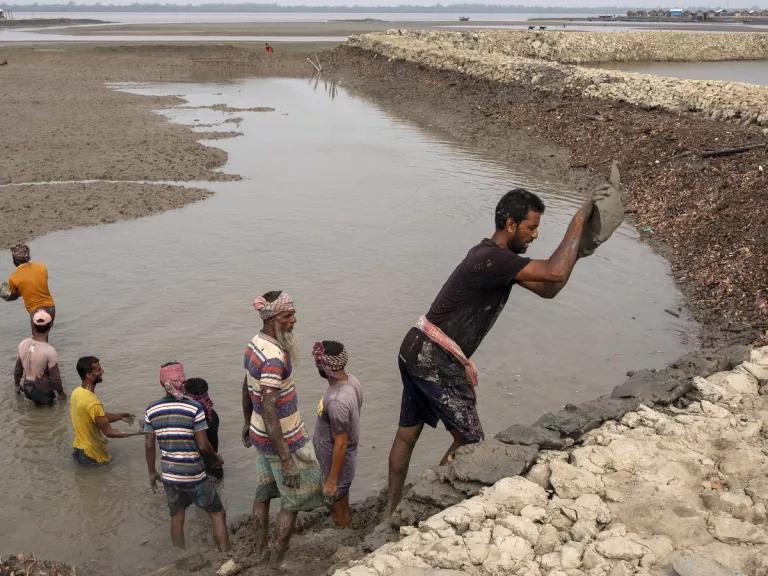
Local residents build a dam to protect a village from high tide flooding in the Sundarbans forest area of Bangladesh, which also suffers water shortages in the dry season due to increasing salinity in the groundwater.
Climate migration
Because of sea level rise and its many impacts, entire populations of several countries, and portions of many others, will have to move, creating potential refugee crises. As Pacific island nations become inundated, hundreds of thousands will be displaced. Even now, more than 50,000 people in the Pacific are forced from their homes every year. Some of those countries have already made resettlement plans. Kiribati has purchased land in Fiji as a potential new home, and New Zealand is working on plans to accept some of the former residents of inundated Pacific islands. (Currently, international law does not recognize sea level rise or climate change as grounds for official refugee status but advocates are pushing for policy changes.)
Climate migration within countries will also become more common. One study estimated that sea level rise could displace somewhere between 2–110 million people in Bangladesh. In the United States, where almost 40 percent of people live in coastal communities, up to 13 million could face displacement from permanent inundation. These population shifts can also trigger climate gentrification ramifications for inland communities, as when high-income households relocate from flood-prone coastal properties to higher-elevation cities, displacing the residents there.
Responses and adaptations to rising sea levels
Sea levels have been changing as long as there have been seas—and life has been shaped by those gradual changes over human history. The problem is that seas are now rising extremely quickly, and existing climate solutions only go so far to protect coastal communities. They only help us to adapt: to reduce the potential for damage, make it easier to rebuild, or make living with the problem more tolerable.
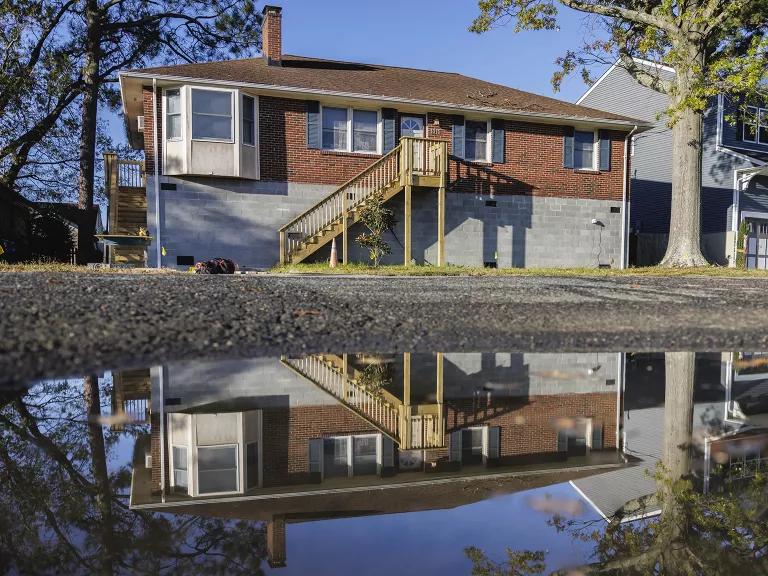
Raising homes, which involves lifting it off the ground and building a new higher foundation below it, is one way homeowners are protecting their properties from flooding.
Strategies for property owners
The first step toward protecting yourself and your property is to understand your flood risk. In the United States, searching flood maps produced by the Federal Emergency Management Agency is a good place to start, as is buying flood insurance—though each of these strategies is not without issues. (Check out our story on the National Flood Insurance Program.) If you live in a particularly vulnerable area, it may be possible to elevate your home or important possessions. And while it is not a light decision, you might consider moving to safer ground.
Strategies for infrastructure
Here are some actions being considered at community and regional levels.
Sea walls
Sea walls are built parallel to the coastline in order to reduce flooding and protect against erosion and storm surge. Of course, building a wall is never as simple as it sounds. These barriers have to be maintained indefinitely and leave little room for strategies that take advantage of local ecosystem services, like living shorelines. When water rushes up against a new wall, it may worsen flooding in the areas outside the wall’s protection. Projects of scale like sea walls, levees, or storm barriers also take a lot of time—and money. In Venice, Italy, the pace of rising seas threatens to make the success of its new $5.3 billion seawalls short-lived.
Elevated roads and water pumps
Less dramatic strategies (but still very expensive and difficult) include elevating roads, upgrading low-lying sewage systems, and installing pumps to remove water that collects during storms or seeps in from seas and rivers. Unfortunately, without also moving homes and businesses out of harm's way, these upgrades aren’t lasting solutions.
Nature-based strategies
Wetlands and dunes naturally diffuse floodwaters and storm surges. One study even found that simply allowing our natural coastal defenses to remain in place would reduce the number of people at risk for sea level rise damage by half. But when we destroy or lose these natural defenses, as what happened in coastal areas around New Orleans for decades before Hurricane Katrina struck, we may face dire consequences.
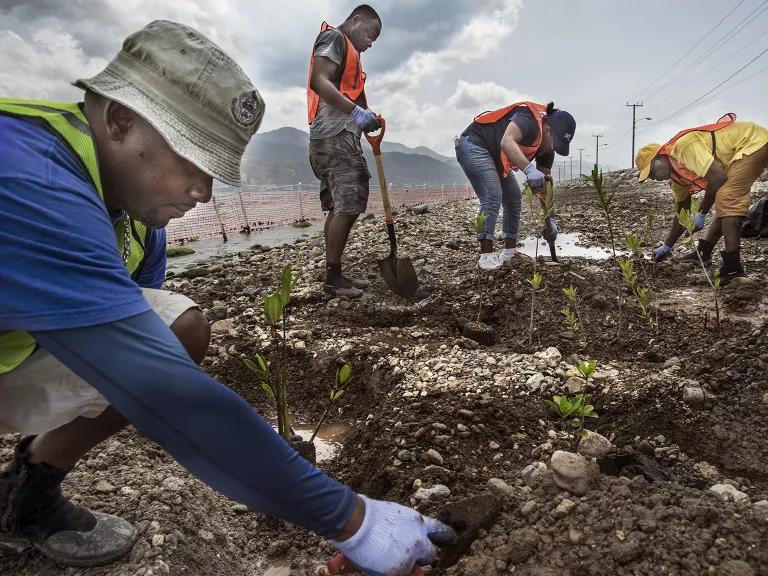
Mangrove saplings grown in a university nursery are being planted to combat erosion on a beach near Kingston, Jamaica.
The most proactive solutions benefit nature and our economy at the same time, to both slow the impacts of sea level rise and support coastal communities. For example, the creation of protected areas that safeguard mangroves, seagrasses, salt marshes, and even oyster beds can also provide recreational opportunities, food, and other local benefits.
Policy solutions
Despite an overwhelming amount of scientific evidence, some climate skeptics and government officials find sea level rise easy to dismiss—or punt the problem to the next generation. But while the pace of change may be too slow to be felt in the course of a single political term, homeowners will soon be feeling the impacts within the life of a 30-year mortgage. Here are some ways we can address these climate realities on a policy level.
Managed retreat
Ideally implemented along with nature-based solutions, managed retreat involves engaging at-risk residents in long-term planning. While communities with heavy flood risk will need to rely on multiple strategies—like the government buying out vulnerable homes, relocating infrastructure to higher ground, and bolstering resilience for areas that cannot be relocated—the goal is to build with the future in mind.
Adaptation funding
Climate change mitigation, through reduced greenhouse gas emissions, is obviously the most powerful solution. But state and federal climate adaptation approaches are also critical. For instance, the National Flood Insurance Program must be reformed to meet the growing threat of flooding; coastal military bases should be defended or moved inland; and both funding and expertise must be directed to flood-threatened communities.
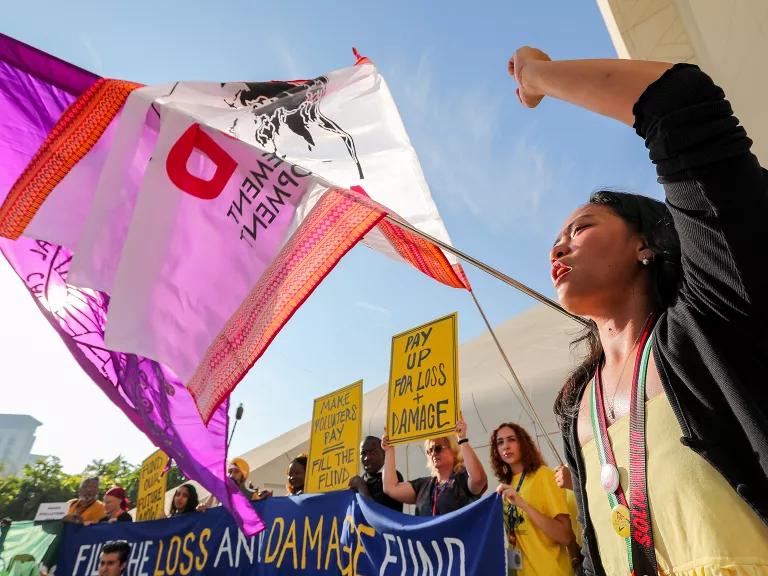
Activists rally during COP28 in support of the Loss and Damage Fund, which was established to provide financial assistance to those nations that are most vulnerable and impacted by climate change.
Global solutions
By now, we know the pace of global emissions reductions determines how fast our seas rise. In order to avoid climate catastrophe and prepare for the effects we’re already starting to experience, major polluting countries and companies must fulfill their promises to act. That includes reducing deforestation and the burning of fossil fuels, investing in climate change solutions like clean energy, and growing support for resources like green banks and the Green Climate Fund (GCF). The GCF is the largest international fund dedicated to helping developing countries fight the climate crisis, with half of its adaptation funding set aside for especially vulnerable countries like small island states. This type of international cooperation provides a lifeline to places where the private sector is least likely to invest—and for the communities who most need it.
This NRDC.org story is available for online republication by news media outlets or nonprofits under these conditions: The writer(s) must be credited with a byline; you must note prominently that the story was originally published by NRDC.org and link to the original; the story cannot be edited (beyond simple things such as grammar); you can’t resell the story in any form or grant republishing rights to other outlets; you can’t republish our material wholesale or automatically—you need to select stories individually; you can’t republish the photos or graphics on our site without specific permission; you should drop us a note to let us know when you’ve used one of our stories.

Climate Tipping Points Are Closer Than Once Thought
1.5 Degrees of Global Warming—Are We There Yet?
What Are the Solutions to Climate Change?
Climate Tipping Points Are Closer Than Once Thought
1.5 Degrees of Global Warming—Are We There Yet?
What Are the Solutions to Climate Change?
Climate Tipping Points Are Closer Than Once Thought
1.5 Degrees of Global Warming—Are We There Yet?
What Are the Solutions to Climate Change?
Climate Tipping Points Are Closer Than Once Thought
1.5 Degrees of Global Warming—Are We There Yet?